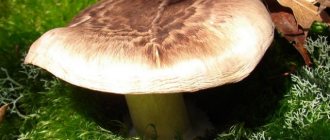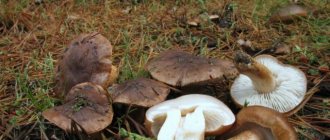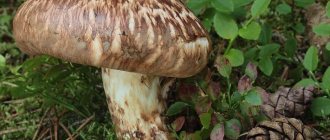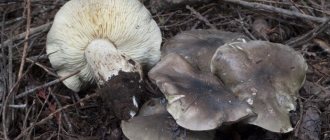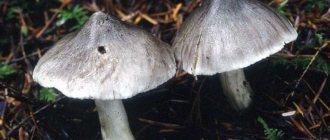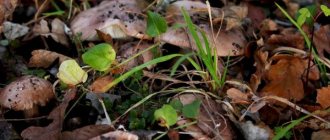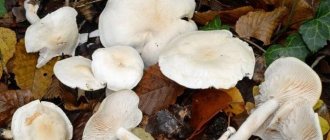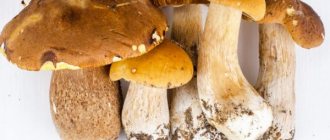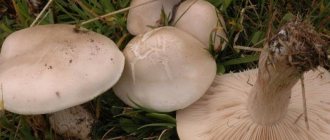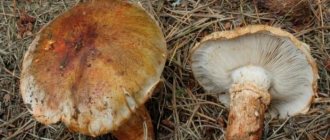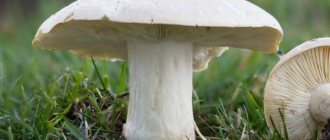Matsutake is an edible mushroom of the Agaricomycetes class, genus Tricholoma, family Ryadovkov. Often also found under the name Japanese truffle, shod row and pine mushroom. Where does the mushroom grow? This type of mushroom can be found in Asian countries, mainly in China, Korea, and Japan. It is also possible to see matsutake mushroom on the menu of restaurants in Finland, the Far East, Sweden, and North America. You can find a booted rower in its habitat areas, especially at the roots of coniferous trees. It is because of the peculiarities of its cultivation that the mushroom received another name: pine.
Matsutake has a brown scaly cap, a stalk twenty centimeters long, and a stalk at least three centimeters thick in diameter. The product has an exquisite spicy flavor, vaguely reminiscent of the taste of Greek white wine. It is problematic to get the product out of the ground, since it is located deep in the soil. The mushroom is quite picky about the environment; for its comfortable growth, the maximum temperature for its growth should be twenty-six degrees, and the minimum air temperature should be fifteen degrees Celsius plus. In order for the mushroom to develop fully and be saturated with the necessary nutrients, one hundred millimeters of precipitation is required in 3 weeks.
Description and characteristics of the mushroom
This representative of the third kingdom of eukaryotic organisms belongs to the Ryadovkov family, the genus Ryadovok. Its Latin name is Tricholoma caligatum. Scientific names: Armillaria matsutake, Armillaria nauseosa, Tricholoma nauseosum. Russian synonyms: spotted row, booted row, pine row, pine horns, pine mushroom, Japanese truffle.
The mushroom cap is from 6 to 20 cm in diameter. Brown in color with a stretch from light to dark tones, with large scales on the surface. With age, the edges of the cap crack, exposing the dense white flesh of the fruit.
The hymenophore (the flesh under the cap) is lamellar and light in color. The spores are small and dark in color.
When cut, the pulp emits a fruity aroma of ripe pear, with the smell of pine and cinnamon. It may turn blue when pressed.
The leg is long, up to 20 cm. It thickens at the bottom, its diameter is 1.5–2.5 cm. It is light before the ring, after it it is dark brown. Hidden under a layer of pine needles, foliage and soil.
How to grow a booted row
Growing shod rows is a rather complex process. The algorithm is similar to growing champignons. The crop is planted in May; dry straw and horse manure or bird droppings can be used as soil. They can be grown in garden beds or at home. A prerequisite is compliance with the temperature regime - the air temperature should not fall below 15°C.
After planting, it is very important to create high humidity. You need to add soil, the average thickness of which is 5 cm. For successful cultivation there must be a sufficient level of light, as well as fresh air.
If you want to grow matsutake yourself, take into account all the requirements. Growing conditions must be suitable. It is best to use a summer cottage for these purposes, since at home these mushrooms do not have enough light and air, which leads to their death.
Time and place for collecting wild pine mushrooms
Translated from Japanese, “matsutake” means “pine mushroom,” which indicates the peculiarity of the growth of the species. It lives in forests at the foot of the roots of red pines on moss or in fallen pine needles. It grows in groups, often forming rings around trees. Prefers old groves, 40–60 years old.
Pine row is ascetic, but also picky about its living conditions: it loves infertile, dry soil. Under the mycelium, the soil becomes whitish.
Interesting! By improving nutrition (adding fallen leaves), the environment becomes unsuitable for the growth of these fruits.
Places of distribution: forests of Japan, Korea, China, Finland, Sweden, North America. In Russia it grows in the Urals, in the Primorsky Territory, and is now included in the Red Book of Primorye. Sometimes found in Belarus and Ukraine.
Fruiting under favorable weather conditions begins in August and can continue until November. The depth of the spotted row into the soil layer and forest floor allows it to easily tolerate autumn frosts. But the most active period for growing and picking mushrooms is September - October.
How to find a shod row
This type of mushroom is distinguished by the fact that it grows quite deep. In some cases, the row has to be dug up, since its leg is located far in the ground. It is quite difficult to detect it with the naked eye. The mushroom picker has to carefully peer into the ground, since more often the row is camouflaged under fallen leaves or under moss.
Mostly matsutake hides under white moss, but is sometimes found under coniferous trees or oaks. The mushroom is located at the very foot of the tree, and it grows only in oak trees that are at least 70 years old. The row grows around the tree trunk, forming a ring shape.
It is necessary to search in infertile soil. When the leaves fall, the soil becomes most fertile, and in such conditions the fungus stops reproducing. This explains that the row does not bear fruit in the same place for more than 8 years.
Matsutake grows only under certain climatic conditions. It can only be found in areas where the daytime temperature does not exceed 26°C, while at night the temperature does not drop below 15°C. It grows most readily during periods of heavy rainfall.
Important! When collecting rows, it is forbidden to break the mycelium; it must be cut with a knife, otherwise it will lead to the death of the whole family.
Additional information about mushroom picking in this video:
Growing at home and in the country
Ryadovka shod is perhaps the only mushroom that grows only in natural, wild conditions and which is very problematic to “tame.”
Japanese witty scientists claim that anyone who can find a way and technique for artificially breeding it is worthy of the Nobel Prize. Therefore, industrial cultivation of the fungus from mycelium is still considered impractical.
True, in China they learned to grow it on a special substrate. However, these fruits are practically devoid of a natural specific aroma and have a bitter taste. And chemistry and agricultural technology reduce the beneficial properties of fruits - they are not suitable for medicinal purposes.
False doubles
In appearance, the spotted row may look like honey mushrooms, but it has a wider cap and a stocky leg. Matsutake has a lot in common in appearance with the capillary mushroom (Tricholoma focale), which belongs to the fourth category of conditionally edible mushrooms.
Its cap is also fibrous-scaly, brown in color, there is also a ring on the stem, the flesh is light and fleshy. But unlike the booted row, it has a short stem that can be easily removed from the ground, and its smell is mealy. The pine mushroom is very similar to Sakhalin champignons.
Attention! Matsutake has no dangerous doubles.
All external features of these types can be seen in the photo.
Comparative table of characteristics of similar mushrooms
| Name | hat | Hymenophore | Pulp | Leg |
| Matsutake | Brown, with large scales; diameter – 6–20 cm. | Lamellar, light color. | Dense white with the smell of fruit, pine, cinnamon. | Long, up to 20 cm; with a diameter of 1.5–2.5 cm. The fringed ring is unevenly located. |
| Real honey fungus | From honey-brown to olive; 3–10 cm in diameter. With sparse scales. | Lamellar, whitish-flesh color. | Whitish, pleasant smell. | 8–10 cm long, 1–2 cm in diameter. Covered with scales. Ring at the top. |
| Open-shaped row | 5 – 10 cm in diameter, reddish-brown or orange-red, with drooping edges. | The plates are frequent, notched, yellowish in color. | White, elastic, with the smell of fresh flour, slightly bitter. | Relatively short, from 4 to 10 cm long, up to 3 cm in diameter. Ring-skirt at the top. The lower part is painted to match the cap. |
| Sakhalin champignon | Diameter – 8–30 cm. Whitish, gray with age. Almost flat, the edge is folded. | Whitish, dense, attached or slightly drooping. | Dense, hard, milky in color. | Length – 15 cm, diameter – 5 cm, white. It is thickened in the middle and narrowed at the base. Deeply rooted, has a double ring. |
Story
There are more than 10 different types of shod rows recognized in the world. But the most famous and revered of them is young shoots with very small caps and a fairly large stalk. The price of a copy can reach very high figures. Most often, the cost is equal to the price of wild ginseng.
Thanks to the cost of matsutake, a kind of “mushroom fever” began in the United States 30 years ago. Companies became interested in the mushroom after discovering that the Japanese were willing to pay very large sums for it. So entrepreneurs began to hire mushroom pickers to collect shod mushrooms and paid as much as $200 for 1 kilogram. This amount led to the fact that thousands of people went on a quiet hunt in the forests of northwestern America and began to literally comb their tracts.
Later, due to such widespread interest, the price of the mushroom dropped significantly, but there are still many people willing to sell it at a wholesale price today. Today, in a year with a high harvest of rows, mushroom pickers earn about $100 a day. Americans also appreciated the taste and benefits of matsutake, thanks to which a significant share of the crop remains in the country.
In Korea, matsutake has been incredibly popular since ancient times. “Pine mushrooms” are mentioned in folk historical chronicles. They were valued incredibly highly, thanks to which in the 14th century a decree was even issued that stated that all collected rows had to be sent straight to the royal palace.
Records dating back to the 19th century say that one of the Korean governors reported to the king that an official had been demoted for failing to bring fresh matsutake to the king’s table. But in the end, the king forgave the official.
Medicinal properties and contraindications
Pine horns are endowed with many healing qualities and are used in folk medicine. They contain a large amount of folic acid, potassium, magnesium, ergothioneine, lecithin, polysaccharides, protein, natural antibiotics (fomecin, clitocin), vitamins of various groups.
Spotted row reduces the amount of cholesterol in the blood, strengthens the immune system, prevents diabetes, and has a powerful antioxidant effect. It copes with hypertension, viral diseases, and is recommended for use in diseases of the joints, genitourinary system, infertility, gastric ulcers, and atherosclerosis.
Used for various external problems - wounds, bites, bedsores.
The mushroom is also capable of defeating more serious ailments: it is used in complex therapy for malignant tumors, in the last stages of cancer. Pine row has proven itself well as a natural cosmetic product. Its extract improves the appearance of the skin, brightens it, and eliminates unwanted pigmentation. The drug reduces the activity of tyrosinase, which synthesizes melanin, without causing side effects.
In matsutake per 100 g – 28 kcal:
- proteins – 3.9 g;
- fat – 0.7 g;
- carbohydrates – 1 g;
- dietary fiber – 1.2 g;
- ash – 0.8 g;
- water – 89.5 g.
It also contains glucose (0.2 g) and fructose (1.5 g) per 100 g.
In its chemical composition, the exotic mushroom is close to meat, which makes it a product indicated for consumption by vegetarians. Its low fat content allows those who are on a diet to regulate their weight without harm to health.
There are no special contraindications for the shod row. It is only possible that it may be poisoned during long-term storage or that there may be individual intolerance to its components. In the latter case, you should not eat the mushroom.
Tincture with vodka or alcohol: indications for use
Matsutake tincture is taken to treat malignant diseases and tumors.
Recipe 1
Components:
- vodka – 500 ml;
- Japanese truffles – 5 kg.
Preparation:
- Clean the raw materials from dirt and rinse.
- Place in a glass container and fill with vodka.
- Leave for 2 weeks in a place protected from direct sunlight.
The infusion can be used externally and orally:
- Soak a piece of gauze folded in four or more in the solution. Place it on the problem area and remove it after 30 minutes.
- Internal reception is carried out using the “slide” method. The first time you need to drink one drop. The next day another one is added to it. The total number is brought to 25. Then the dose is reduced in the reverse order.
Reference! For skin lesions, you can also systematically make an ointment based on matsutake.
Recipe 2 (for external use)
Components:
- spotted rows - 100 g;
- Vaseline or rendered lard – 200 g
How to prepare:
- Chop the mushrooms and combine with the base.
- Place in a cool place for 10 days.
- After this, you can lubricate the sore spots with it at night. In the morning, cleanse the skin of residues.
Attention! Therapeutic success depends on several factors, but the most important of them is the quality of the raw materials.
How to use for oncology
In the Land of the Rising Sun, the shod row is considered the best anti-cancer remedy and is used for blood diseases. And the healers of the Celestial Empire are convinced that the fruits have the greatest healing power within 48 hours after collection; it is during this period that they have the maximum effect on leukemia.
Moreover, young, full-fledged specimens are used. The mushroom should be eaten raw, cut into thin slices. Or dry it at a temperature not exceeding 50 ºС, then it will retain all its healing properties.
Mature mushrooms, the cap of which has opened, no longer have such power and are used as a preventive anticancer agent that cleanses the body of radionuclides and carcinogens.
Use in cosmetology
Cosmetology today is experiencing a mushroom boom. Japanese truffles have not been left out either; they are actively used in the beauty industry. One of the products containing matsutake extract, for example, is the Guru of Radiance mask, which is used for adult skin.
With the constant use of cosmetics based on the shoe line, the following effect is observed: the unique composition removes wrinkles, unwanted skin pigmentation, and makes the skin light and fresh.
Face mask with pine mushroom
It uses matsutake mushroom extract. Eastern cosmetology believes that it provides unfading youth, removes free radicals from the body, and inhibits the aging process of the skin. Ready-made fabric-based masks can be easily purchased in specialized or online stores. They should be used as follows:
- Wipe the skin with lotion.
- Place the mask on your face and smooth it out.
- Leave on skin for 5–15 minutes.
- Then remove, distribute the essence evenly with patting movements, and allow it to be absorbed.
It is recommended to make such masks 2 times a week.
Application
In cooking
Delicacies from the shoe row have the aroma of pine and pear and are highly valued by gourmets. In most cases, matsutake is not served as a separate dish, but in addition to soups, salads, appetizers and side dishes. Often mushrooms are not subjected to heat treatment, simply cut into transparent slices so that their unusual aroma is more pronounced.
Connoisseurs divide mushrooms into categories according to smell and taste. Elite rows are usually supplied from Russian Primorye. Young, unbloomed mushrooms are more valuable. Only fresh matsutake is used; when dried or frozen, they lose their unique smell and original taste.
In medicine
All the beneficial, medicinal properties of mushrooms are used in Japanese medicine; mushroom powder is used to make preparations that help fight influenza viruses; tinctures are prepared that lower blood pressure, regulate the functioning of the stomach and intestinal tract, and help with diabetes (lower sugar levels). Medicines from mushrooms are used in the complex treatment of cancer. Matsutake is part of the meshima mushroom extract (strengthening immunity).
Assessment of taste qualities, benefits and possible harm
Due to their exquisite taste, aroma and nutritional value, pine rows are widely used in cooking in many countries, especially in the East. Their slippery legs have a nice crunchy texture and are the most “appetizing” part. There is no bitterness in matsutake.
The most common cooking method is roasting over hot coals. Citrus sauce is used as a seasoning. Or the fruits are processed using a steam grill, wrapped in foil and poured with sake.
They also boil soup, stew it, cook it with chicken and rice or in a pot with fish, and add it to salad. Matsutake can be salted and pickled, but this is not practical for economic reasons.
Important! Matsutake mushroom as a food product is not frozen or dried, since with such processing methods its aromatic qualities are lost.
Primary processing and cleaning
Before cooking, just rinse the raw materials lightly under water and wipe with a clean cloth. The legs of the spotted row are not cut off, unlike other mushrooms, only their hard part is removed (a couple of centimeters from the root). Then the fruits are broken into pieces by hand or cut into slices.
When preparing dishes, it is very advisable not to overcook matsutake, as this reduces their wonderful subtle aroma and reduces the amount of nutrients. Sometimes the fruits are even eaten raw - then all the advantages of the product are preserved to the maximum.
Dishes with matsutake
“Royal” mushroom cooked on the grill is a rather expensive pleasure. Therefore, dishes using it as an additive or side dish are most widespread.
The base is saturated with a mushroom smell, forming a new, exotic one, and the taste is enriched with additional shades.
Matsutake Gohan Recipe
Ingredients:
- Japanese truffle – 100 g;
- rice – 2 cups;
- dashi (fish broth) – 300 ml;
- deep-fried tofu cheese – 100 g;
- soy sauce – 2 tbsp. l.;
- sake – 2 tsp.
Cooking process:
- Rice needs to be washed several times in cold water, it should become transparent. Then let it drain.
- Place the dashi broth and rice in a rice cooker and leave for half an hour.
- Cut the pine horns into strips.
- Cut fried tofu into thin strips.
- Place mushrooms, cheese, sake and sauce into a rice cooker and set to cooking.
- Bring to readiness.
Matsutake dobin mushi
Components:
- pine row – 1 piece;
- chicken thighs – 8 small pieces;
- dashi broth - 3 cups;
- lime – 4 slices;
- peeled shrimp – 4 pcs.;
- salt – 15 ml;
- soy sauce – 15 ml;
- sake – 40 ml.
Cooking:
- Cut the mushrooms lengthwise.
- Pour sake, sauce, dashi broth into a saucepan and bring to a boil. Add salt.
- Divide the shrimp and chicken thighs into pieces and place in clay teapots. Pour in soup.
- Keep in a steam bath for about 15 minutes.
- Pour into cups and add lime slices.
Pickling
Pine horns processed in this way are crispy and very dense, retaining their aroma and all the beneficial substances. Can be used for cooking in winter.
To do this you need to take:
- matsutake – 0.5 kg;
- salt – 3 – 4 tsp;
- vinegar – 1 tsp;
- spices (black pepper, bay leaf, garlic) - to taste.
Salting process:
- The stems are separated from the caps and cut into 3-4 pieces.
- The fruits are placed in sterilized jars with their caps down. The gaps are filled with parts of the legs.
- Sprinkle the layer with salt and spices.
- Then you need to lay the next layer of mushrooms, also adding seasonings and salt. Repeat the phases.
- The last layer is covered with spices. Oppression is placed on top.
The product will be ready in 1.5 months.
